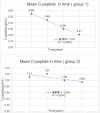Changes in C-Peptide Values in Children with Type 1 Diabetes - a Three-Year Study
- PMID: 37588842
- PMCID: PMC10427091
- DOI: 10.26574/maedica.2023.18.2.182
Changes in C-Peptide Values in Children with Type 1 Diabetes - a Three-Year Study
Abstract
Background: C-peptide is used as an important indicator of residual insulin secretion in patients diagnosed with type 1 diabetes mellitus (T1DM) and treated with insulin. Aim:We have aimed to monitor the serum C-peptide (CP) levels during the first three years after diagnosis of T1DM in a cohort of children admitted to the Diabetes Department of "M. S. Curie" Emergency Clinical Hospital for Children, Bucharest, Romania, and to investigate the factors that could influence the rate of decline in its secretion. Method:We conducted a longitudinal, retrospective cohort study on a group of 215 children and adolescents who met the inclusion criteria and were monitored in our clinic over the course of a long period of time. We analyzed several parameters, including fasting serum CP values at diagnosis and yearly throughout T1DM evolution, the severity of diabetic ketoacidosis (DKA) at onset, HbA1c at diagnosis, family history of T1DM/T2DM, patient gender and presence of concurrent acute infectious disease at diagnosis, with the purpose of evaluating their influence on the preservation of endogenous insulin secretion. Based on serum CP value measured three years after T1DM onset, patients were divided into two groups: group 1, with low insulin residual secretion (CP < 0.6 ng/mL), and group 2, with preserved insulin residual secretion (CP ≥0.6 ng/mL) Results:At the moment of diagnosis, patients in group 1 were younger than those in group 2 (6.03 ± 3.54 years and 9.76 ± 2.75 years, respectively). The proportion of children with diabetic ketoacidosis (DKA) at onset was greater in group 1 (68% of patients) than group 2, in which the majority of subjects (60%) did not have DKA. The C-peptide value at diagnosis was significantly lower (0.55 ± 0.36 ng/mL) among patients in group 1 than those in group 2 (1.11 ± 0.59 ng/mL). In group 1 there was a higher proportion of patients (65%) with acute infectious disease at onset. Family history of T1DM/T2DM was associated with a more rapid decline in CP values. Our data showed no correlation between CP levels monitored for three years and HbA1c at diagnosis and no association with the gender of each patient. Conclusion:Patients with higher CP concentrations at diagnosis maintained increased values (> 0.6 ng/mL) three years after disease onset. Younger children had a faster decline of CP secretion during the first three years following diabetes diagnosis. In patients with severe symptoms (DKA) and associated infectious disease at onset, a risk of rapid CP decline was found.
Figures






References
-
- Otto-Buczkowska E. Przydatność oznaczania peptydu C w diabetologii [The clinical utility of C-peptide measurement in diabetology]. Pediatr Endocrinol Diabetes Metab. 2015;20:63–68. - PubMed
-
- Nordwall M, Ludvigsson J. Clinical manifestations and beta cell function in swedish diabetic children have remained unchanged during the last 25 years. Diabetes Metab Res Rev. 2008;24:472–479. - PubMed
-
- Ludvigsson J, Carlsson A, Forsander G, et al. C-peptide in the classification of diabetes in children and adolescents. Pediatr Diabetes. 2012;13:45–50. - PubMed
Publication types
LinkOut - more resources
Full Text Sources
Miscellaneous
